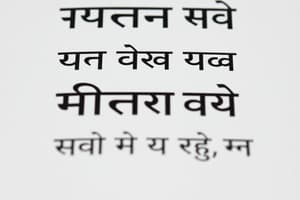Podcast
Questions and Answers
What language family does Hindi belong to?
What language family does Hindi belong to?
- Dravidian
- Sino-Tibetan
- Indo-Aryan (correct)
- Austroasiatic
In which country is Hindi chiefly spoken?
In which country is Hindi chiefly spoken?
- Nepal
- India (correct)
- Pakistan
- Bangladesh
How many official languages does the Government of India have?
How many official languages does the Government of India have?
- One
- Three
- Four
- Two (correct)
From which language did Hindi evolve?
From which language did Hindi evolve?
During which period did Hindustani become prominent?
During which period did Hindustani become prominent?
Which script is used for writing Hindi?
Which script is used for writing Hindi?
What type of word order does Hindi have?
What type of word order does Hindi have?
Instead of prepositions, Hindi uses:
Instead of prepositions, Hindi uses:
Standard Hindi is based on which dialect?
Standard Hindi is based on which dialect?
Which language has NOT significantly influenced Hindi vocabulary?
Which language has NOT significantly influenced Hindi vocabulary?
What is Hindi cinema commonly known as?
What is Hindi cinema commonly known as?
In Hindi-speaking states, Hindi is often taught as a what?
In Hindi-speaking states, Hindi is often taught as a what?
Which of these poets wrote in Hindi during the medieval Bhakti period?
Which of these poets wrote in Hindi during the medieval Bhakti period?
What is the revival of Sanskrit words to replace foreign loanwords known as?
What is the revival of Sanskrit words to replace foreign loanwords known as?
Where is code-switching between Hindi and English most common?
Where is code-switching between Hindi and English most common?
Flashcards
Indo-Aryan Language
Indo-Aryan Language
A language family originating from ancient India.
Hindi
Hindi
The primary language spoken in India and an official language of the Indian government.
Hindi's Origin
Hindi's Origin
Early Vedic Sanskrit is the ancestor language of Hindi.
Hindustani
Hindustani
Signup and view all the flashcards
Devanagari Script
Devanagari Script
Signup and view all the flashcards
Official Language Status (India)
Official Language Status (India)
Signup and view all the flashcards
Subject-Object-Verb (SOV)
Subject-Object-Verb (SOV)
Signup and view all the flashcards
Agglutinative Language
Agglutinative Language
Signup and view all the flashcards
Hindi Dialect Continuum
Hindi Dialect Continuum
Signup and view all the flashcards
Hindi Vocabulary Influences
Hindi Vocabulary Influences
Signup and view all the flashcards
Sanskritization
Sanskritization
Signup and view all the flashcards
Bollywood
Bollywood
Signup and view all the flashcards
Code-Switching
Code-Switching
Signup and view all the flashcards
Bhakti Poets
Bhakti Poets
Signup and view all the flashcards
Central Hindi Directorate
Central Hindi Directorate
Signup and view all the flashcards
Study Notes
- Hindi is an Indo-Aryan language.
- It is spoken chiefly in India.
- Modern Standard Hindi is one of the two official languages of the Government of India.
- It is an official language in 9 States and 3 Union Territories.
- Hindi is the fourth most spoken language in the world.
Origin and History
- Hindi's ancestor language is early Vedic Sanskrit.
- It evolved through various stages.
- These stages include Old Indo-Aryan, Middle Indo-Aryan, and finally to the Modern Indo-Aryan stage.
- During the Delhi Sultanate period, the Apabhramsa languages started to coalesce.
- This coalescence formed what is known as Hindustani.
- Hindustani became prominent around the 13th century.
- Hindustani served as a lingua franca across northern India.
- In the 18th century, Hindustani began to diverge into two distinct forms: Hindi and Urdu.
- Hindi adopted the Devanagari script.
- Hindi drew vocabulary from Sanskrit.
- Urdu adopted a modified Persian script.
- Urdu drew vocabulary from Persian and Arabic.
Official Status
- Hindi is one of the two official languages of the Union Government of India, along with English.
- Article 343(1) of the Constitution states that the official language of the Union shall be Hindi in Devanagari script.
- The Constitution also originally mandated the use of English for all official purposes for a period of 15 years.
- This was extendable.
- The Official Languages Act of 1963 allowed for the continued use of English.
- Hindi is also an official language at the state level.
- States and territories where Hindi is an official language include Uttar Pradesh, Himachal Pradesh, Delhi, Bihar, Haryana, Chhattisgarh, Jharkhand, Madhya Pradesh, Rajasthan, Uttarakhand, Andaman and Nicobar Islands, Chandigarh and Dadra and Nagar Haveli and Daman and Diu.
Linguistic Features
- Hindi is an Indo-Aryan language derived from Sanskrit.
- It exhibits features typical of Indo-Aryan languages.
- Hindi has a subject-object-verb (SOV) word order.
- It is a head-final language, meaning that modifiers typically precede the words they modify.
- Hindi has postpositions instead of prepositions.
- Hindi is an agglutinative language.
- Grammatical relations are often marked through suffixes attached to words.
- Nouns in Hindi are inflected for gender (masculine and feminine), number (singular and plural), and case.
- Verbs are inflected for tense, aspect, mood, gender, and number.
- Hindi distinguishes between inclusive and exclusive "we" pronouns.
- Hindi also has a system of honorifics.
- Honorifics reflect social status, respect, and familiarity.
Dialects
- Hindi exists along a dialect continuum.
- Dialects transition into related languages like Punjabi, Rajasthani, and Maithili.
- Standard Hindi is based on the Khariboli dialect.
- Other dialects include Braj Bhasha, Awadhi, and Bhojpuri.
- These dialects have their own distinct literary traditions.
- Some are seeking official recognition as separate languages.
Writing System
- Hindi is written in the Devanagari script.
- Devanagari is also used for other languages like Sanskrit, Marathi, and Nepali.
- Devanagari is an abugida.
- Each consonant has an inherent vowel.
- Vowels can be written as independent letters or diacritics.
- The script is written from left to right.
- Words are separated by spaces.
- Devanagari has a rich set of symbols for representing various sounds.
Vocabulary
- The vocabulary of Hindi has been influenced by Sanskrit, Persian, Arabic, and English.
- Sanskrit provides the core vocabulary.
- Persian and Arabic have contributed loanwords.
- English has introduced modern and technical terms.
- The process of Sanskritization continues.
- Sanskritization involves the revival of Sanskrit words.
- Sanskritization helps to replace foreign loanwords.
Hindi Cinema
- Hindi cinema, also known as Bollywood, is a major cultural force.
- It produces a large number of films each year.
- Bollywood films are popular in India and abroad.
- Hindi film songs have a significant impact on popular culture.
- Many terms from film making, such as "Bollywood" itself, have integrated into the language.
Education
- Hindi is taught as a compulsory subject in most schools in Hindi-speaking states.
- It is also offered as an optional subject in non-Hindi-speaking states.
- The Central Hindi Directorate promotes the use of Hindi.
- The Central Hindi Directorate encourages the development of Hindi.
- Various universities and institutions offer courses in Hindi language and literature.
Literature
- Hindi literature has a rich history.
- Medieval Bhakti poets like Kabir, Tulsidas, and Mirabai wrote in Hindi.
- Modern Hindi literature includes novels, short stories, poems, and plays.
- Prominent writers include Premchand, Mahadevi Varma, and Nirmal Verma.
Influence of English
- English has had a significant influence on Hindi.
- English words are commonly used in urban areas.
- Code-switching between Hindi and English is common, especially among younger generations.
- English has influenced the development of new Hindi vocabulary.
- The influence of English also poses challenges to the promotion of Hindi.
Studying That Suits You
Use AI to generate personalized quizzes and flashcards to suit your learning preferences.




